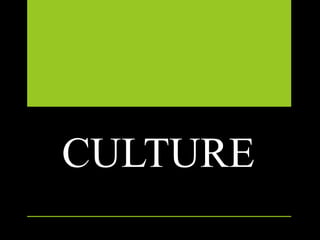
Culture
- 1. CULTURE
- 2. What is Culture? The set of learned behaviors, beliefs, attitudes, values, and ideals that are characteristics of a particular society or population ( Ember,1999). The learned norms, values, knowledge, artifacts, language, and symbols that are constantly communicated among people who share a common way of life (Calhoun et.al., 1994).
- 3. The sum total of symbols, ideas, forms of expressions and material products associated with a collective way of life reflected in such things as beliefs, values, music, literature, art, dance, science, religious ritual and technology(Johnson, 1996). The complex whole which includes knowledge, beliefs, art, morals, law, custom, and any other capabilities and habits acquired by man as a member of society (Panopio, 1992).
- 4. Characteristics of Culture 1. Culture is learned. 2. Culture is shared by a group of people. 3. Culture is cumulative. 4. Cultures change.
- 5. 5. Culture is dynamic. 6. Culture is ideational. 7. Culture is diverse. 8. Culture gives us a range of permissible behaviour.
- 7. Components of Culture Communication Cognitive Behavioral Material
- 8. Components of Culture A. Communication Component A. 1. Language It defines what it means to be human. It forms the core of all culture. They share a condensed, very flexible set of symbols and meanings. 2. Symbols It forms their backbone of symbolic interaction. Anything that carries a particular meaning recognized by people who share culture. Serve as the basis for everyday reality.
- 9. B. Cognitive Component 1. Ideas/ Knowledge/Beliefs Ideas are mental representations ( concepts, categories, metaphor) used to organize stimulus; they are the basic units out of which knowledge is constructed an a world emerges. Knowledge the storehouse where we accumulate representations, information, facts, assumptions, etc. Beliefs accept a proposition, statement, description of fact, etc. as true.
- 10. 2. Values- Defined standards of desirability, goodness and beauty, which serve as broad guidelines for social living. They support beliefs, or specific statements that people hold to be true. 3. Accounts- How people use that common language to explain, justify, rationalize, excuse, or legitimize behavior to themselves and others.
- 11. C. Behavioral Component ( how we act) 1. Norms Rules and expectations by which a society guides the behavior of its members. Standards that define the obligatory and expected behaviors of people in various situations
- 12. Types of Norms Mores They are customary behaviour patterns of folkways which have taken on a moralistic value. Laws Laws constitute the most formal and important norms. The more deemed so vital to dominant interests that they become translated into legal formalizations that even non-members of society are required to obey.
- 13. Folkways These are behaviour patterns of society which are organized and repetitive. There is no strong feeling of right or wrong attached to them. They are simply the way the people usually do things. Commonly known as customs Rituals These are highly scripted ceremonies or strips of interaction that follow a specific sequence of actions. They occur at predetermined times or triggered by specific cues.
- 14. D. Material Component The form and function of objects is an expression of culture and culturally-defined behaviour.
- 15. The Organization of Culture Cultural Traits Material culture refers to the physical objects, resources, and spaces that people use to define their culture. These include homes, neighborhoods, cities, schools, churches,temples,to ols, means of production, goods and products, stores, and so forth. Non-material culture refers to the nonphysical ideas that people have about their culture, including beliefs, values, rules, norms, morals, language, organizatio ns, and institutions.
- 16. How is Culture Transmitted? 1. Enculturation It is the process of learning culture of one’s own group. 2. Acculturation It is the process of learning some new traits from another culture. 3. Assimilation The process in which an individual entirely loses any awareness of hi/her previous group identity and takes on the culture and attitudes of another group.
- 17. Importance and Functions of Culture 1. Helps the individual fulfil his potential as a human being. 2. Through the development of culture man can overcome his physical disadvantages and allows him to provide himself with fire, clothing, food and shelter. 3. Provides rules of proper conduct for living in a society. 4. Provides the individual his concepts of family, nation and class.
- 18. Thank you! Donna O. Fernandez
